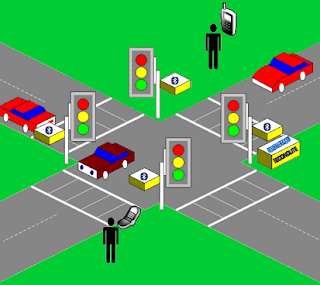Labeling is an important concept in life to understand. If an object is not labeled, then it is open to be labeled many different things from other people. Take the example of a street light intersection:

In a street intersection there are certain rules and regulations that are followed so that traffic runs smoothly. First and foremost is that the same labels apply nationwide. That for the traffic lights, green means go, red means stop, and yellow means slow down. This is an important label and distinction that needs to be made because if it is not made then some people might believe yellow is go(since everybody speeds up when the light is yellow anyway). This mislabel can cause big problems and the intersection might end up looking like this:
In this picture traffic is backed up all 4 ways and there seems to be no order or flow of traffic in this picture. Labeling which color we give significance is an important part of this system.
Another important part of labeling is that everybody (drivers) must know about the labels. If they do not know that green means go, then the label is ineffective. This ties in nicely with communication in that it is great to label a system, however, one must also communicate to other people the items that they labeled. Another aspect of this system is pedestrian cross walks. Pedestrians who want to cross the street have a certain system that they need to go through. Specifically pushing a button that tells the street light system that a pedestrian wants to cross the street. This brings up the system within a system. Specifically the street light system. This system consist of signals, cameras, patterns, that help in identifying which street or traffic way gets permission to go across the street. The system usually consist of whether or not it senses a car in the turn left lane or if a pedestrian wishes to go across the street. From there, the street light orientates itself a certain way, so that it can be the most effective. The label of whether or not car is trying to turn left or if a pedestrian wants to cross the street, or not definite labels in which there is one name for them, however they are indeed important for this system. Even if there is no word label, there is still a certain label applied to this situation. These labels are also important to the system, they are the labels without a name. These are the labels that are intuitive and are ones that most people know about, yet have no name. This doesn't matter though because everything in a system has one label or another. It is like in Back of the Napkin, in which pictures are drawn, yet some items are drawn more detailed than others, however the over all meaning of the picture is clear to all.
Labeling plays an important role in life and also engineering. In life, labels, like the example above, are important in order to keep a natural order in life, to create less chaos then necessary. In engineering it is important to label so that everybody knows how you came to this conclusion and may try to improve or solve the problem that occurred in the project. Since, the communication of what each label means is universal to a certain degree of engineering, everybody understands the project. That is the importance of labeling, not only understanding what is said, but also in other people understanding and acknowledging the label for what it is.

Alysia, you make an excellent point about how labels must be shared between both parties involved if they are to be effective. Onur made a similar point, too, and I agree that it's all part of the big picture of communication.
ReplyDeleteYou made a very good point that people must know what the labels actually mean for them to become useful. Labels by themselves could possibly be self-explanatory but some things do indeed need explanations
ReplyDeleteI am amused by the traffic light example you give and by how effectively you used it to convey the idea that labels should be familiar to both parties.
ReplyDelete